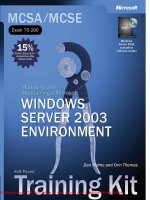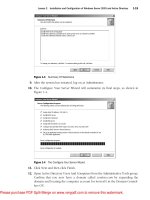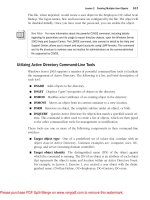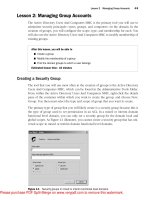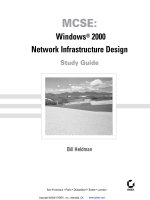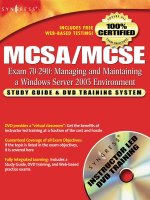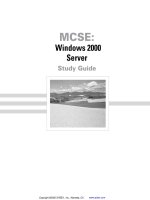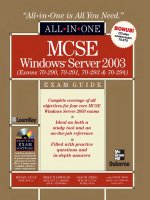Tài liệu MCSE Windows server 2003- P10 ppt
Bạn đang xem bản rút gọn của tài liệu. Xem và tải ngay bản đầy đủ của tài liệu tại đây (3.57 MB, 50 trang )
!
Lesson 4 Implementing RAID
11
-
35
Up to 32 disks can participate in a striped volume. The amount of space used on each
disk in the volume will be equal to the smallest amount of space on any one disk. For
example, if Disk 1 has 200 GB of unallocated space, and Disk 2 has 120 GB of space,
the striped volume can contain, at most, 240 GB as the size of the stripe on Disk 1 can
be no greater than the size of the stripe on Disk 2. All disk space in the volume is used
for data; there is no space used for fault tolerance.
Recovering a Striped Volume
Because data is striped over more than one physical disk, performance is enhanced,
but fault tolerance is decreased—there is more risk because if any one drive in the vol-
ume fails, all data on the volume is lost. It is important to have a backup of striped data.
If one or more disks in a striped volume fails, you must delete the volume, replace the
failed disk(s) and recreate the volume. Then you must restore data from the backup.
Exam Tip
Striped volumes provide maximum storage and performance but support no fault
tolerance. The only recovery potion is that of your regular backup routine.
Mirrored Volumes
A mirrored volume provides good performance along with excellent fault tolerance.
Two disks participate in a mirrored volume, and all data is written to both volumes. As
with all RAID configurations, use separate controllers (by adding a controller, you cre-
ate a configuration called “duplexing”) for maximum performance. Mirrored volumes
relate to RAID-1 hardware configurations.
Create Mirrored Volumes
To create a mirrored volume, you must have unallocated space on two dynamic disks.
Right-click one of the spaces and choose Create Volume. The New Volume Wizard will
step you through the process of selecting a mirrored volume and choosing space on
another disk to include in the volume. Mirrored volumes can be assigned a drive letter
and folder paths. Both copies of the mirror share the same assignment.
You can also mirror an existing simple volume by right-clicking the volume and choos-
ing Add Mirror and selecting a drive with sufficient unallocated space.
Once you have established the mirror, the system begins copying data, sector by sec-
tor. During that time, the volume status is reported as Resynching.
Recovering from Mirrored Disk Failures
The recovery process for a failed disk within a mirrored volume depends on the type
of failure that occurs. If a disk has experienced transient I/O errors, both portions of
Please purchase PDF Split-Merge on www.verypdf.com to remove this watermark.
11-36
Chapter 11 Managing Microsoft Windows Server 2003 Disk Storage
the mirror will show a status of Failed Redundancy. The disk with the errors will report
a status of Offline or Missing, as seen in Figure 11-8.
Figure 11-8 A mirrored volume with a failed disk
After correcting the cause of the I/O error—perhaps a bad cable connection or power
supply—right-click the volume on the problematic disk and choose Reactivate Volume
or right-click the disk and choose Reactivate Disk. Reactivating brings the disk or vol-
ume back online. The mirror will then resynchronize automatically.
If you want to stop mirroring, you have three choices, depending on what you want
the outcome to be:
■
Delete the volume If you delete the volume, the volume and all the information
it contains is removed. The resulting unallocated space is then available for new
volumes.
■
Remove the mirror If you remove the mirror, the mirror is broken and the
space on one of the disks becomes unallocated. The other disk maintains a copy of
the data that had been mirrored, but that data is of course no longer fault-tolerant.
■
Break the mirror If you break the mirror, the mirror is broken but both disks
maintain copies of the data. The portion of the mirror that you select when you
choose Break Mirror maintains the original mirrored volume’s drive letter, shared
folders, paging file, and reparse points. The secondary drive is given the next
available drive letter.
Knowing that information, how do you suppose you would replace a failed disk—a
member of the mirrored volume that simply died? Well, after physically replacing the
disk, you will need to open Disk Management to rescan, initialize the disk and convert
it to dynamic. After all that work you will find that you can’t remirror a mirrored vol-
ume, even though half of it doesn’t exist. So far as the remaining disk is concerned, the
mirrored volume still exists—its partner in redundancy is just out to lunch. You must
Please purchase PDF Split-Merge on www.verypdf.com to remove this watermark.
!
Lesson 4 Implementing RAID
11
-
37
remove the mirror to break the mirror. Right-click the mirror and choose Remove Mir-
ror. In the Remove Mirror dialog box, it is important to select the half of the volume
that is missing; the volume you select will be deleted when you click Remove Mirror.
The volume you did not select will become a simple volume. Once the operation is
complete, right-click the healthy, simple volume and choose Add Mirror. Select the
new disk and the mirror will be created again.
Exam Tip
Mirrored volumes provide fault tolerance and better write performance than
RAID-5 volumes. However, because each disk in the mirror contains a full copy of the data in
the volume, it is the least efficient type of volume in terms of disk utilization.
RAID-5 Volumes
A RAID-5 volume uses three or more physical disks to provide fault tolerance and
excellent read performance while reducing the cost of fault tolerance in terms of disk
capacity. Data is written to all but one disk in a RAID-5. That volume receives a chunk
of data, called parity, which acts as a checksum and provides fault tolerance for the
stripe. The calculation of parity during a write operation means that RAID-5 is quite
intensive on the server’s processor for a volume that is not read-only. RAID-5 provides
improved read performance, however, as data is retrieved from multiple spindles
simultaneously.
As data in a file is written to the volume, the parity is distributed among each disk in
the set. But from a storage capacity perspective, the amount of space used for fault tol-
erance is the equivalent of the space used by one disk in the volume.
From a storage capacity perspective, that makes RAID-5 more economical than mirror-
ing. In a minimal, three disk RAID-5 volume, one-third of the capacity is used for par-
ity, as opposed to one-half of a mirrored volume being used for fault tolerance.
Because as many as 32 disks can participate in a RAID-5 volume, you can theoretically
configure a fault-tolerant volume which uses only 1/32 of its capacity to provide fault
tolerance for the entire volume.
Configure RAID-5 Volumes
You need to have space on at least three dynamic disks to be able to create a RAID-5
volume. Right-click one disk’s unallocated space and choose New Volume. The New
Volume Wizard will step you through selecting a RAID-5 volume type, and then select-
ing the disks that will participate in the volume.
The capacity of the volume is limited to the smallest section of unallocated space on
any one of the volume’s disks. If Disk 2 has 50 GB of unallocated space, but Disks 3
and 4 have 100 GB of unallocated space, the stripe can only use 50 GB of space on
Disks 3 and 4—the space used on each disk in the volume is identical. The capacity,
Please purchase PDF Split-Merge on www.verypdf.com to remove this watermark.
11-38
Chapter 11 Managing Microsoft Windows Server 2003 Disk Storage
or Volume Size reported by the New Volume Wizard will represent the amount of
space available for data after accounting for parity. To continue our example, the
RAID-5 volume size would be 100 GB—the total capacity minus the equivalent of one
disk’s space for parity.
RAID-5 volumes can be assigned a drive letter or folder paths. They can be formatted
only with NTFS.
Because RAID-5 volumes are created as native dynamic volumes from unallocated
space, you cannot turn any other type of volume into a RAID-5 volume without back-
ing up that volume’s data and restoring into the new RAID-5 volume.
Recovering a Failed RAID-5 Volume
If a single disk fails in a RAID-5 volume, data can continue to be accessed. During read
operations, any missing data is regenerated on the fly through a calculation involving
remaining data and parity information. Performance will be degraded and, of course,
if a second drive fails it’s time to pull out the backup tapes. RAID-5 and mirrored vol-
umes can only sustain a single drive failure.
If the drive is returned to service, you may need to rescan, and then you will need to
right-click the volume and choose Reactivate Volume. The system will then rebuild
missing data and the volume will be fully functional again.
If the drive does not offer a Reactivate option, or if you have had to replace the disk,
you may need to rescan, initialize the disk, convert it to dynamic, then right-click the
volume and choose Repair Volume. You will be asked to select the disk where the
missing volume member should be recreated. Select the new disk and the system will
regenerate the missing data.
Mirrored Volumes versus RAID-5 Volumes
Mirrored volumes (RAID-1) and RAID-5 volumes provide different levels of fault toler-
ance. Deciding which option to implement depends on the level of protection you
require and the cost of hardware. The major differences between mirrored volumes
and RAID-5 volumes are performance and cost. Table 11-2 describes some differences
between software-level RAID-1 and RAID-5.
Table 11-2
RAID Performance and Costs
Mirrored Volumes (RAID-1) Striped Volumes with Parity (RAID-5)
Can protect system or boot parti- Cannot protect system or boot partition
tion
Requires two hard disks Requires a minimum of three hard disks and allows a max-
imum of 32 hard disks
Please purchase PDF Split-Merge on www.verypdf.com to remove this watermark.
Lesson 4 Implementing RAID
11
-
39
Table 11-2
RAID Performance and Costs (Continued)
Mirrored Volumes (RAID-1) Striped Volumes with Parity (RAID-5)
Has a higher cost per MB Has a lower cost per MB
50 percent redundancy
*
33 percent maximum redundancy
*
Has good read and write Has excellent read and moderate write performance
performance
Uses less system memory
Requires more system memory
* drive space dedicated or “lost” to provide fault tolerance
Creating Fault Tolerance for the System Volume
Because RAID-5 is a native dynamic volume, it is not possible to install or start the
Windows Server 2003 operating system on a RAID-5 volume created by the Windows
Server 2003 fault-tolerant disk technologies.
Tip
Hardware RAID, however, is invisible to Windows Server 2003, so the operating system
can (and should, where available) be installed on hardware RAID arrays.
The only option for creating fault tolerance for the system, without buying hardware
RAID, is thus to mirror the system volume. You can mirror the system volume by fol-
lowing the procedures described for creating a mirrored volume: right-click the system
volume and choose Add Mirror. Unlike Windows 2000, you do not need to restart, and
the BOOT.INI file is updated automatically so that you can start to the secondary drive
if the primary drive fails.
If the drives are attached to IDE controllers, and the primary drive fails, you may have
to remove that drive, change the secondary drive to the primary controller and set its
jumpers or cable position so that it is the master. Otherwise, the system may not boot
to the secondary drive.
Tip
If you are going to mirror the system volume, do so on one or two SCSI controllers. If
you use two controllers, make sure they are of the same type. This configuration will be the
most easily supported and recovered.
Please purchase PDF Split-Merge on www.verypdf.com to remove this watermark.
11-40
Chapter 11 Managing Microsoft Windows Server 2003 Disk Storage
Upgrading Disks
There are two potential “gotchas” when you upgrade disks from previous ver-
sions of Windows, or attempt to move disks to a Windows Server 2003 computer
from a computer running a previous version of Windows.
First, if a disk was configured in a Windows 2000 computer as a basic disk, then
was converted to dynamic, you cannot extend that disk’s simple volumes onto
other disks using Windows Server 2003. In other words, if you move that disk to a
Windows Server 2003 computer, or upgrade the operating system to Windows
Server 2003, you cannot create spanned volumes out of the disk’s simple volumes.
Second, Windows Server 2003 no longer supports multidisk arrays created in
Windows NT 4. Windows NT 4 created mirrored, striped, and striped-with-parity
(RAID-5) sets using basic disks. Windows 2000 permitted the use of those disk
sets, although it was important to convert the sets to dynamic quickly in order to
facilitate troubleshooting and recovery. Windows Server 2003 does not recognize
the volumes. On the off chance that you upgrade a server from Windows NT 4 to
Windows Server 2003, any RAID sets will no longer be visible. You must first back
up all data prior to upgrading or moving those disks, and then, after recreating
the fault-tolerant sets in Windows Server 2003, restore the data.
Practice: Planning RAID Configuration
In this practice, you will evaluate a server and its storage capacity against the require-
ments of contoso.com and determine an appropriate configuration.
You administer a server for Contoso, Ltd. The server has four disks on a SCSI subsystem:
■
Disk 0: 80 GB
■
Disk 1: 80 GB
■
Disk 2: 40 GB
■
Disk 3: 40 GB
You recently performed a clean installation of Windows Server 2003 by backing up all
data on the disks, removing all partitions from those disks, and installing the operating
system on a 20 GB partition on Disk 0.
You are now required to configure all the remaining drive space. User data will not be
stored on the operating system volume. You want to maximize data storage and ensure
uptime in the event of a single disk failure. What configuration do you implement, and
what will the total storage capacity for user data be?
Please purchase PDF Split-Merge on www.verypdf.com to remove this watermark.
Lesson 4 Implementing RAID
11
-
41
The answer is a combination of RAID-5 and mirrored volumes with a total capacity for
user data of 140 GB.
To ensure uptime in the event of a single disk failure, you must provide fault tolerance
for the operating system itself. Only a mirrored volume is capable of doing that; you
cannot install or host the operating system on a RAID-5 volume. A minimum disk space
of 20 GB is therefore required to mirror the operating system.
A RAID-5 configuration maximizes disk space without sacrificing single disk failure
fault tolerance. You can configure a RAID-5 volume with three or more disks. In this
scenario, configuring a RAID-5 volume with all four disks would maximize data stor-
age. A RAID-5 volume’s stripe can only be as wide as the smallest amount of unallo-
cated space, so although disk 0 and 1 have 60 and 80 GB free, respectively, the smaller
(40 GB) drives will determine the capacity of the volume. With a 40 GB space on four
drives, the volume has a potential capacity of 160 GB, but RAID-5 uses the space
equivalent to one disk for parity, meaning that the resulting capacity for data storage in
this volume will be 120 GB.
That leaves disk 0 with 20 GB of unallocated space, and disk 1 with 40 GB of unallo-
cated space. You can configure the mirror of the operating system volume on disk 1,
leaving 20 GB on that drive. The remaining space (20 GB per disk on disks 0 and 1)
can be configured as a mirrored volume for user data, with a storage capacity of 20 GB.
A simple, spanned, or striped volume would not be fault-tolerant, and a RAID-5 vol-
ume requires a minimum of three physical disks, so a mirror is the most effective way
to use remaining space for fault-tolerant data storage.
Lesson Review
The following questions are intended to reinforce key information presented in this
lesson. If you are unable to answer a question, review the lesson materials and try the
question again. You can find answers to the questions in the “Questions and Answers”
section at the end of this chapter.
1. You’re implementing software RAID on your Windows Server 2003 computer. You
want to provide fault tolerance to the system and boot partitions. Which version of
RAID should you use?
a. RAID-0
b. RAID-1
c. RAID-5
d. You cannot use software RAID to protect a boot partition.
Please purchase PDF Split-Merge on www.verypdf.com to remove this watermark.
11-42
Chapter 11 Managing Microsoft Windows Server 2003 Disk Storage
2. You’re setting up a Windows Server 2003 computer and you want to protect the
data on the hard disk. You want to implement a solution that provides the fastest
disk I/O possible and supports the hot swapping of hard disks. Which RAID solu-
tion should you use?
a. RAID-0
b. RAID-1
c. RAID-5
d. Hardware RAID
3. You’re setting up RAID-5 on your Windows Server 2003 computer. You plan to use
five hard disks, which are each 20 GB in size. What percentage of redundancy can
you anticipate with this configuration?
a. 20
b. 25
c. 33
d. 50
4. You’re setting up software RAID on your Windows Server 2003 computer to pro-
vide fault tolerance to the data stored on that system. The computer is used as a
database server. The server performs many read operations but relatively few
write operations. As a result, you want a fault-tolerant solution that provides excel-
lent read performance. Which RAID solution should you use?
a. RAID-0
b. RAID-1
c. RAID-5
5. A computer where you want to implement RAID-5 contains three disks, each with
2 GB of unallocated space. Using the Disk Management snap-in, you start the New
Volume Wizard by right-clicking one of the regions of unallocated space. When
you reach the Select Volume Type screen, the RAID-5 option is not available. What
is the most likely reason for this behavior?
a. RAID-5 is already implemented in hardware.
b. One or two of the disks are configured with the basic storage type.
c. All three disks are configured with the dynamic storage type.
d. All three disks are configured with the basic storage type.
e. RAID-5 is already implemented in software.
Please purchase PDF Split-Merge on www.verypdf.com to remove this watermark.
Lesson 4 Implementing RAID
11
-
43
6. A disk in a mirrored volume is failing. You decide to replace the failing disk. How
should you prepare the mirror for disk replacement?
Lesson Summary
■
Some levels of RAID provide fault tolerance by implementing data redundancy.
You can implement RAID fault tolerance as either a software or hardware solution.
■
Hardware solutions offer better performance than software solutions, but they are
generally more expensive.
■
Windows Server 2003 supports three software implementations of RAID: striped
volumes (RAID-0), mirrored volumes (RAID-1), and striped-with-parity volumes
(RAID-5).
■
A striped volume (RAID-0) distributes data across each disk in the volume, provid-
ing increased read and write performance, but no benefit to fault tolerance.
■
In a RAID-5 volume, fault tolerance is achieved by adding a parity-information
stripe to each disk partition in the volume.
■
A mirrored volume uses the fault tolerance driver to write the same data to a vol-
ume on each of two physical disks simultaneously.
■
The major differences between mirrored volumes and RAID-5 volumes are perfor-
mance and cost. Mirrored volumes offer good read and write performance. RAID-5
volumes offer better read performance than mirrored volumes, but only moderate
write performance.
■
The only form of software RAID that can be used for the system volume is a mir-
rored volume.
Case Scenario Exercise
Note
This case scenario requires Internet access.
You are a server administrator for Contoso, Ltd. The company’s file servers are running
out of disk capacity, and it is necessary to upgrade. In the past, the company has relied
on tape backups for data redundancy. Due to recent growth, it is no longer acceptable
to encounter more than a few minutes of downtime if a server disk drive fails. You
have therefore been asked to evaluate disk storage options that provide fault tolerance.
Please purchase PDF Split-Merge on www.verypdf.com to remove this watermark.
11-44
Chapter 11 Managing Microsoft Windows Server 2003 Disk Storage
Exercise 1: Consider Windows Server 2003 Fault-Tolerant Volumes
Review the information in Lesson 4 to consider how you could best configure fault-
tolerant servers using Windows Server 2003 dynamic volumes. Use the Practice in
Lesson 4 as a reminder of how various types of volumes can be configured to support
fault tolerance.
Consider the challenges related to IDE drives. If the operating system is installed on a
mirrored IDE drive and the primary drive fails, you must reconfigure the secondary
drive’s jumpers or cable position, and ensure it is attached to the primary IDE channel.
With that in mind, you decide that a more robust configuration would utilize two SCSI
controllers with one copy of the mirror as the first disk on each SCSI chain. That con-
figuration would enable rapid recovery not only from a single drive failure, but from
the failure of one of the SCSI controllers as well.
Now consider the performance and capacity effect of Windows Server 2003 RAID.
Consider the amount of time that will be required to recover if a drive fails—downing
the server, replacing the drive, restarting the server—and the amount of time it will take
to regenerate a missing volume.
Exercise 2: Consider Hardware RAID
With all those thoughts in mind, you decide to examine hardware RAID as an option.
What advantages does hardware RAID provide? See Lesson 4 for some of the answers.
Open Internet Explorer and browse to the Web site(s) of one or more computer hard-
ware and supply vendors. Search their sites for RAID arrays. You will find RAID arrays,
which include disk drives, and RAID controllers and RAID enclosures, to which you
must add drives. Focus on the ready-to-go RAID arrays and answer the following
questions:
■
What options are available?
■
What are some of the vendors of hardware RAID arrays?
■
What types of storage capacities do hardware RAID arrays offer?
■
What RAID configurations do the hardware RAID arrays implement? Are there
configurations that Windows Server 2003 does not support?
■
What is the price range for a hardware RAID array?
■
What do some entry-level RAID arrays cost?
Please purchase PDF Split-Merge on www.verypdf.com to remove this watermark.
Chapter 11 Managing Microsoft Windows Server 2003 Disk Storage
11
-
45
At the time of this writing, hardware RAID solutions offering 720 GB of storage—that’s
closer to a terabyte than to the size of any single drive in most servers—can be pur-
chased for less than $3,000.
How would you position the value of hardware RAID to your manager? Would you rec-
ommend hardware RAID over Windows Server 2003 RAID? Why or why not?
Troubleshooting Lab
You are a server administrator for Contoso, Ltd. You inherited a server from a previous
administrator that contains numerous internal SCSI disk drives. You open the Disk
Management console to determine the configuration of those drives and their volumes.
The configuration is shown below:
The weather forecast calls for a brutal storm to move into the city early tomorrow
morning. To play it safe, you start a backup of your server on your way out the door.
The storm is quite strong, forcing businesses, including yours, to be closed for several
days. Electricity is lost to Contoso’s building and, eventually, the batteries in your unin-
terruptible power supplies (UPSs) are drained, causing power to your servers to be
completely lost. During the first few hours in which electricity is restored, several
power fluctuations and surges are experienced.
Please purchase PDF Split-Merge on www.verypdf.com to remove this watermark.
11-46
Chapter 11 Managing Microsoft Windows Server 2003 Disk Storage
When you return to the server room, you boot the servers. Your server indicates errors,
and you open Disk Management to see the following, frightening graphical view of
your disks and volumes:
Two drives have failed in the server. One contained a mirror of the operating system
volume. The other contained several volume types, including portions of a spanned, a
striped, and a RAID-5 volume.
You have an 80 GB drive, still in its box. You shut down the server and remove the two
failed drives. After inserting the new disk, you reboot the server.
Exercise
Take a moment, on a separate piece of paper, to plot the steps that will be required to
recover the data on each volume that was lost. Be thorough. Include the steps required
to clean up the missing disks and volumes as well as install, configure, and replace
data on the new disk.
When you are confident that you have as comprehensive a list of steps as possible,
compare your answer to the answer.
The components of recovery will include the following:
1. Log on to the system.
2. Finish installing the new disk drive. Follow any instructions presented by the
Found New Hardware Wizard. If the Found New Hardware Wizard does not
appear, check Device Manager to see if the disks installed automatically and
silently. If the disks do not appear, use Add Hardware to install the disks.
Please purchase PDF Split-Merge on www.verypdf.com to remove this watermark.
Chapter 11 Managing Microsoft Windows Server 2003 Disk Storage
11
-
47
3. Open Disk Management.
4. Detect and initialize the new disk. Disk Management will likely detect the new
disk and present the Initialize Disk Wizard. If the wizard does not appear, check
to see if the disk appears in Disk Management and, if not, right-click Disk Man-
agement and choose Rescan. Once the disk appears, right-click the disk and
choose Initialize.
5. Recover the volumes (in any order).
Recover the RAID-5 volume
a. Convert the new disk to a dynamic disk. Right-click the new disk and choose
Convert to Dynamic.
b. Right-click a functioning portion of the RAID-5 volume and choose Repair
Volume. Select the new disk, which has ample space to support a member of
the stripe. The RAID-5 volume will be created and synchronized.
Recover the mirrored volume
a. Remove the mirror. Right-click the failed drive and choose Remove Mirror.
Confirm that the portion marked Missing is selected and click Remove Mirror.
The remaining portion of the mirror becomes a simple volume.
b. Right-click the simple volume and choose Add Mirror. Select the new disk,
which has ample space for the mirror, and click Add Mirror. The mirror will
be created and synchronized.
Recover the striped volume
a. Delete the volume. Striped volumes are not fault-tolerant. All data on the vol-
ume was lost.
b. Re-create the volume. Right-click on unallocated space where the stripe had
existed, and choose New Volume. Select a striped volume and add the new
disk to the stripe. The striped volume will be created and formatted.
c. Restore data from the backup to the striped volume.
Recover the spanned volume
a. Delete the volume. Spanned volumes are not fault-tolerant. All data on the
volume was lost.
b. Re-create the volume. Right-click on unallocated space where the volume had
existed, and choose New Volume. Select a spanned volume and add the new
disk to the stripe. Select the appropriate amount of space to use on the new
disk. The spanned volume will be created and formatted.
c. Restore data from the backup to the spanned volume.
Please purchase PDF Split-Merge on www.verypdf.com to remove this watermark.
11-48
Chapter 11 Managing Microsoft Windows Server 2003 Disk Storage
6. Remove the missing disks. Right-click the missing disks and choose Remove Vol-
ume. You cannot remove the disk with the missing mirror until after the mirror has
been removed. You cannot remove the disk with the simple, spanned, and RAID-5
volumes until those volumes have been deleted and repaired.
7. Run CHKDSK after all volumes have been resynchronized and restored.
Chapter Summary
■
Windows Server 2003 supports two types of storage, basic and dynamic, and sev-
eral file systems, including FAT, FAT32, and NTFS. Most advanced storage manage-
ment features are available only on dynamic disk volumes formatted as NTFS.
■
Dynamic disks provide flexible and powerful options in configurations with more
than one disk. You can implement spanned, mirrored, striped, and RAID-5 vol-
umes to provide storage according to capacity, performance, and fault tolerance
requirements.
■
Disk volumes can be corrupted, can become fragmented, and often fill to capacity.
Check Disk, Disk Defragmenter, and Disk Quotas are tools to help you manage
existing volumes.
■
Not all RAID configurations are fault-tolerant—mirrored and RAID-5 volumes are
fault-tolerant, but striped volumes are not. None of the Windows Server 2003 vol-
ume types will provide fault tolerance if more than one disk fails in the volume.
Exam Highlights
Before taking the exam, review the key points and terms that are presented below to
help you identify topics you need to review. Return to the lessons for additional prac-
tice and review the “Further Readings” sections in Part 2 for pointers to more informa-
tion about topics covered by the exam objectives.
Key Points
■
Understand the impact on capacity, performance, and fault tolerance for each type
of disk volume. Be prepared to recommend disk configurations based on storage
requirements.
■
Know how to implement user disk quotas and the effect of both default quota set-
tings and specific quota entries.
■
Recognize and repair a volume that was temporarily offline but is now recon-
nected: Rescan and Reactivate Disk or Reactivate Volume, and CHKDSK.
■
Know how to rebuild fault-tolerant volumes (mirrored and RAID-5 volumes) on a
replaced disk and the appropriate commands that are used: Rescan, Initialize,
Convert to Dynamic Disk, Break Mirror, Remove Mirror, and Repair Volume.
Please purchase PDF Split-Merge on www.verypdf.com to remove this watermark.
Chapter 11 Managing Microsoft Windows Server 2003 Disk Storage
11
-
49
Key Terms
Simple volume The equivalent to a basic disk partition is a dynamic disk simple
volume. Because simple volumes exist on only one physical disk, they are not
fault-tolerant.
Spanned volume A spanned volume includes space on more than one physical
disk. Because their size tends to be greater, and because multiple physical disks
are involved, the risk for failure increases, and spanned volumes are not fault-
tolerant.
Striped volume Data is written to 2 to 32 physical disks at the same rate. Offers max-
imum performance and capacity but no fault tolerance.
Mirrored volume Two disks contain identical copies of data. The only software
RAID supported on the system volume. Good read and write performance; excel-
lent fault tolerance; but costly in terms of disk utilization, because 50 percent of
the volume’s potential capacity is used for data redundancy.
RAID-5 volume Data is written to 3 to 32 physical disks at the same rate, and is inter-
laced with parity to provide fault tolerance for a single disk failure. Good read perfor-
mance; good utilization of disk capacity; expensive in terms of processor utilization
and write performance as parity must be calculated during write operations.
Please purchase PDF Split-Merge on www.verypdf.com to remove this watermark.
11-50
Chapter 11 Managing Microsoft Windows Server 2003 Disk Storage
Questions and Answers
Page
11-9
Lesson 1 Review
1. You are installing a new 200 GB disk drive. You want to divide the disk into five
logical volumes for the operating system, applications, user home directories,
shared data, and a software distribution point. The drive space should be distrib-
uted equally among the five logical volumes. You also want to leave 50 GB as
unallocated space for future extension of a logical volume. Considering basic and
dynamic disks and the types of logical volumes they support, what are your con-
figuration options?
Allocate 150 GB of disk space to leave 50 GB unallocated. That means that each of the five log
ical volumes will be 30 GB. You can configure the drive as a basic disk with zero to three pri
mary partitions, each of which supports one logical drive (which is the logical volume for a
basic disk). The remaining two to five logical volumes would be created as logical drives in an
extended partition. If the disk is configured as a dynamic disk, all five logical volumes would be
set up as simple volumes. Although these configurations are valid answers to the question, the
best practice in this scenario would be to configure the disk as a dynamic disk, for reasons you
will learn in the next lesson.
2. Which of the following provide the ability to recover from the failure of a single
hard drive?
a. Primary partition
b. Extended partition
c. Logical drive
d. Simple volume
e. Spanned volume
f. Mirrored volume
g. Striped volume
h. RAID-5 volume
The correct answers are f and h.
3. You are dual-booting a system in your test lab. The computer has Windows NT 4
installed on the first primary partition, and Windows Server 2003 installed on the
second primary partition. The computer is running low on disk space, so you add
a new disk drive. You boot to Windows Server 2003 and configure the drive as a
dynamic disk. When you later restart to Windows NT 4, you are unable to see the
disk. Why?
Only Windows XP, Windows 2000, and the Windows Server 2003 family support dynamic disks.
Please purchase PDF Split-Merge on www.verypdf.com to remove this watermark.
Questions and Answers
11
-
51
4. To provide fault tolerance, maximum performance, and the ability to hot-swap a
failed drive, you purchase a seven-disk hardware RAID array. After installing the
array, you see only one new disk on Windows Server 2003. Why?
Once configured, hardware disk subsystems with an independent controller abstract, or mask,
the physical disk structure from the operating system. They manage the operation and I/O to
the disks in the array. Operating system performance is not affected by having to calculate par
ity or perform mirrored write operations.
Page
Lesson 2 Review
11-22
1. This question continues the scenario that was presented in question 1 of the
review in Lesson 1. You have installed a new 200 GB disk drive. You configured
it as a basic disk and created three primary partitions of 30 GB each to host the
operating system, user home directories, and shared data. You configured an
extended partition and two logical drives of 30 GB each to host applications
installed on the machine and a software distribution point. There remains 50 GB
of unallocated space on the disk. Several months later, you notice that three of the
volumes are nearing capacity. You want to prepare for the likely event that one or
more partitions will need to be expanded. What action must you take?
You must convert the disk to a dynamic disk. A partition on a basic disk can only be extended
to immediately contiguous unallocated space. By converting the disk to a dynamic disk, you will
convert each primary partition and logical drive to a simple volume. Simple volumes can be
extended into any unallocated space.
2. What type of disk region supports logical drives?
a. Primary partitions
b. Simple volumes
c. Spanned volumes
d. Extended partitions
e. Unallocated space
The correct answer is d.
3. You recently added a disk to a computer. The disk had previously been used in a
Windows 2000 Server. The disk appears in Device Manager, but is not appearing
correctly in Disk Management. What task must you apply?
a. Import Foreign Disk
b. Format volume
c. Rescan
d. Change Drive Letter or Path
e. Convert to Dynamic Disk
The correct answer is c.
Please purchase PDF Split-Merge on www.verypdf.com to remove this watermark.
11-52
Chapter 11 Managing Microsoft Windows Server 2003 Disk Storage
4. You attempt to convert an external FireWire disk from basic to dynamic, but the
option to convert is not available. What is the most likely reason for this?
A removable disk cannot be converted to a dynamic disk. External drives are considered
removable.
Page
Lesson 3 Review
11-31
1. You’re the administrator of a Windows Server 2003 computer. You want to fix any
file system errors and recover any bad sectors on your computer’s hard disk.
Which tool should you use?
a. Check Disk
b. Disk Defragmenter
c. DISKPART
d. Disk quotas
The correct answer is a.
2. You’re the administrator of a Windows Server 2003 computer. The computer’s
hard disk contains two data volumes: D and E. You enable disk quotas on volume
D and E that limit all users to 20 MB of total storage. However, you want to limit
storage in the users’ home folders, stored in D:\Users, to 10 MB per user. Is this
possible? Why or why not? Where can you implement quotas?
a. On any server for all disks
b. On any physical disk for all volumes
c. On any volume for all folders
d. On any folder
The correct answer is c. You can implement quotas per-volume only. You cannot configure a
quota on the Users folder on volume D. The quota applies to the whole volume. You will also be
unable to set a quota of 20 MB per user of combined storage on volumes D and E. You could,
however, configure a limit of 15 MB on volume D and 5 MB on volume E, or some other combi
nation that totals 20 MB.
3. What is the required amount of free disk space on a volume in order to provide
for complete defragmentation?
a. 5 percent
b. 10 percent
c. 15 percent
d. 25 percent
e. 50 percent
The correct answer is c.
Please purchase PDF Split-Merge on www.verypdf.com to remove this watermark.
Questions and Answers
11
-
53
Page
11-41
Lesson 4 Review
1. You’re implementing software RAID on your Windows Server 2003 computer. You
want to provide fault tolerance to the system and boot partitions. Which version of
RAID should you use?
a. RAID-0
b. RAID-1
c. RAID-5
d. You cannot use software RAID to protect a boot partition.
The correct answer is b. A mirrored volume can contain any partition, including the boot or sys
tem partition.
2. You’re setting up a Windows Server 2003 computer and you want to protect the
data on the hard disk. You want to implement a solution that provides the fastest
disk I/O possible and supports the hot swapping of hard disks. Which RAID solu-
tion should you use?
a. RAID-0
b. RAID-1
c. RAID-5
d. Hardware RAID
The correct answer is d. Although hardware RAID is more expensive than software fault toler
ance, it provides faster disk I/O than software fault tolerance. In addition, hardware fault toler
ance solutions might implement hot swapping of hard disks to allow for replacement of a failed
hard disk without shutting down the computer and hot sparing so that a failed disk is automat
ically replaced by an online spare.
3. You’re setting up RAID-5 on your Windows Server 2003 computer. You plan to use
five hard disks, which are each 20 GB in size. What percentage of redundancy can
you anticipate with this configuration?
a. 20
b. 25
c. 33
d. 50
The correct answer is a. RAID-5 volumes have a cost advantage over mirrored volumes because
disk usage is optimized. The more disks you have in the RAID-5 volume, the less the cost of the
redundant data stripe. If you’re using five disks in a RAID-5 configuration, you can anticipate 20
percent rate of redundancy.
Please purchase PDF Split-Merge on www.verypdf.com to remove this watermark.
11-54
Chapter 11 Managing Microsoft Windows Server 2003 Disk Storage
4. You’re setting up software RAID on your Windows Server 2003 computer to pro-
vide fault tolerance to the data stored on that system. The computer is used as a
database server. The server performs many read operations but relatively few
write operations. As a result, you want a fault-tolerant solution that provides excel-
lent read performance. Which RAID solution should you use?
a. RAID-0
b. RAID-1
c. RAID-5
The correct answer is c. Although RAID-5 has moderate write performance, it has excellent read
performance. RAID-1 has good read and write performance, but the read performance is not as
good as with RAID-5.
5. A computer where you want to implement RAID-5 contains three disks, each with
2 GB of unallocated space. Using the Disk Management snap-in, you start the New
Volume Wizard by right-clicking one of the regions of unallocated space. When
you reach the Select Volume Type screen, the RAID-5 option is not available. What
is the most likely reason for this behavior?
a. RAID-5 is already implemented in hardware.
b. One or two of the disks are configured with the basic storage type.
c. All three disks are configured with the dynamic storage type.
d. All three disks are configured with the basic storage type.
e. RAID-5 is already implemented in software.
The correct answer is b. To configure a RAID-5 volume, at least three disks must be configured
for the dynamic storage type.
6. A disk in a mirrored volume is failing. You decide to replace the failing disk. How
should you prepare the mirror for disk replacement?
Verify that no processes are accessing the mirrored volume. Verify that the mirror failure is due
to a failed disk and not a failing disk controller. Then, using Diskpart or the Disk Management
snap-in, select the failing drive and remove the mirror. After the mirror is removed, shut down
the computer if necessary and replace the failing disk. Restart the computer and, from the
remaining mirror drive, use Diskpart or the Disk Management snap-in to add the mirror. Adding
the mirror will regenerate the mirror to the new disk.
Please purchase PDF Split-Merge on www.verypdf.com to remove this watermark.
